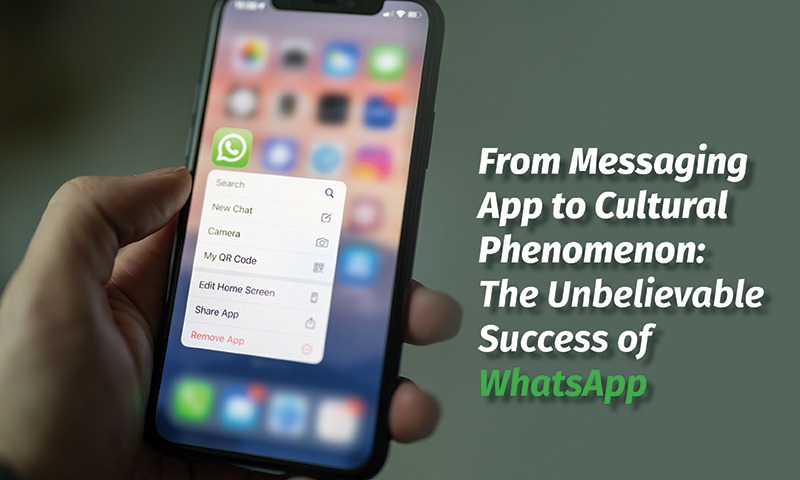In the ever-evolving landscape of technology and communication, there are only a few apps that have managed to transcend their original purpose and become cultural phenomena. WhatsApp is one such application that has achieved remarkable success, revolutionizing the way people connect and communicate across the globe. This long-form article delves into the incredible journey of WhatsApp, exploring its origins, features, and the factors that have contributed to its unprecedented popularity. Join us as we unravel the story behind this messaging app turned cultural phenomenon.
The Birth of WhatsApp
WhatsApp was founded in 2009 by Jan Koum and Brian Acton, two former Yahoo employees. The app was initially designed as a simple messaging platform with a focus on user privacy and security. Unlike traditional SMS services, WhatsApp allowed users to send text messages, photos, videos, and audio files over the internet, thereby eliminating the need for expensive carrier charges.
Intuitive User Interface
One of the key factors that contributed to WhatsApp’s success was its intuitive user interface. The app was designed to be user-friendly, allowing even the least tech-savvy individuals to navigate its features effortlessly. With a clean and minimalist design, WhatsApp prioritized simplicity, making it accessible to a wide range of users across different age groups and demographics.
Seamless Cross-Platform Integration
Another aspect that set WhatsApp apart from its competitors was its seamless cross-platform integration. Whether you were using an iPhone, Android device, or even a basic feature phone, WhatsApp ensured that you could connect and communicate with your contacts seamlessly. This universality in accessibility played a crucial role in the app’s rapid global expansion.
End-to-End Encryption
Privacy and security have always been paramount concerns for users in the digital era. Recognizing this, WhatsApp incorporated end-to-end encryption into its messaging platform. This meant that all user messages and media files were encrypted and could only be decrypted by the intended recipient, ensuring that conversations remained private and protected from unauthorized access.
Multi-Media Sharing Capabilities
WhatsApp’s ability to share various types of media files, including photos, videos, and audio recordings, further contributed to its appeal. Users could instantly capture moments and share them with friends and family, making WhatsApp not just a messaging app but also a platform for visual storytelling and expression.
Group Chats and Broadcast Lists
WhatsApp introduced the concept of group chats and broadcast lists, allowing users to communicate with multiple contacts simultaneously. Whether it was planning a surprise birthday party or coordinating a team project, WhatsApp provided a convenient and efficient way to connect with a group of people in real-time.
Voice and Video Calling
To expand its functionality, WhatsApp later introduced voice and video calling features. This enabled users to make high-quality voice and video calls over Wi-Fi or mobile data, bridging the gap between long-distance communication and face-to-face interaction. WhatsApp’s calling capabilities further solidified its position as an all-in-one communication platform.
Global Adoption and Cultural Impact
WhatsApp’s global adoption and cultural impact cannot be overstated. It quickly gained traction in emerging markets where affordable smartphones and internet access were becoming more prevalent. In regions like India, Brazil, and Southeast Asia, WhatsApp became the primary mode of communication for millions of users, surpassing traditional SMS services and even email.
The WhatsApp Business App
Recognizing the potential for business communication, WhatsApp launched a separate app called WhatsApp Business. This app catered to small and medium-sized enterprises, enabling them to engage with customers, provide support, and showcase their products and services. WhatsApp Business became a valuable tool for businesses, facilitating direct and personalized interactions with their target audience.
Facebook’s Acquisition and Beyond
In 2014, Facebook acquired WhatsApp for a staggering $19 billion, solidifying its position as a dominant force in the messaging app industry. Under Facebook’s ownership, WhatsApp continued to evolve and introduce new features, such as disappearing messages, stickers, and payment integration. The app also expanded into other verticals, such as WhatsApp for Education and WhatsApp for Health, showcasing its versatility and adaptability.
Conclusion
From its humble beginnings as a messaging app to becoming a cultural phenomenon, WhatsApp has redefined the way people communicate in the digital age. Its intuitive interface, cross-platform integration, end-to-end encryption, and diverse feature set have propelled it to unimaginable heights of success. With a global user base in the billions, WhatsApp has left an indelible mark on the world, transcending borders, cultures, and generations. As we look to the future, it is clear that WhatsApp’s influence will only continue to grow, shaping the way we connect and communicate for years to come.












